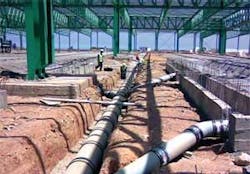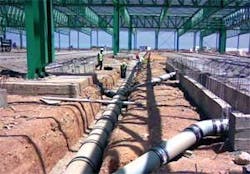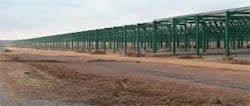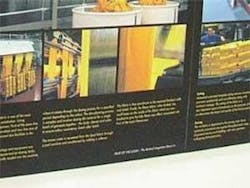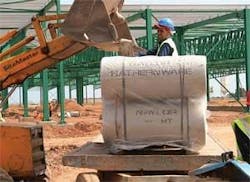Fruit of the Loom Lays Pipe
Naylor Hathernware piping meets rigorous operating requirements at North Africa textile plant
By Ian Clarke
World-renowned clothing manufacturer Fruit of the Loom, whose European headquarters are based in Telford, Shropshire, UK, is currently expanding its manufacturing base by constructing a new textile production plant in Skhirat, Morocco. The new facility is designed to produce fabric from raw cotton through carding and cleaning, spinning, knitting, dyeing and cutting rooms, laid out over a 93,000 m2 production plant building.
Fruit of the Loom has been active in Morocco for over a decade, and this new facility is an important and significant investment in its business. When complete, it’s understood that the factory will be the largest such facility in North Africa, if not the whole of the African continent.
The main production building’s 5,000-ton steel frame, roof and wall cladding is being undertaken by three steelwork companies acting in a joint venture, AIC JV. The production floor slab and masonry walls are being constructed by SOTRAVO – another Moroccan-based contractor CEGELEC. And Laurent Bouillet SA is undertaking the major electrical and mechanical works. Fruit of the Loom’s Irish office is overseeing construction works in conjunction with a site-based project management team
Specialist Pipes
As part of the factory construction process, drainage systems are being installed beneath the factory floor to handle wastewater effluents produced during the various manufacturing and finishing processes. Whilst most effluents are basically benign and relatively easy to handle, one section of the factory requires particular attention: the dye plant.
At times, dye plant effluent isn’t only very high temperature (+100°C) but also chemically active with a variety of different chemicals depending on the dyeing processes undertaken at the time. These severe and adverse operating conditions necessitated specialist wastewater piping.
As part of the design process, UK-based Naylor Drainage was approached by Fruit of the Loom in conjunction with their wastewater system engineering designers, White Young Green, based in the Londonderry, Northern Ireland. Whilst Naylor’s broader offering includes clayware pipes and products for sewerage and more general applications, the company’s Hathernware division, a manufacturer of chemical drainage products, has a portfolio specifically developed to meet dramatic temperature variations (thermal shock) and chemically aggressive effluents.
Naylor Hathernware comprises two principal ranges: FCR (fully chemically resistant) and HT (high temperature). DN100-300 pipes are carried in stock, with larger sizes being made to order and agreed delivery schedules. The HT system consists of plain-end pipes and fittings, made from a specially formulated clay body, which allows them to withstand the thermal shock of a sudden temperature change of up to 120°C. Joints are effected using either HT polypropylene couplings or Band-Seal couplings; special Band-Seal Chemical Couplings are available incorporating a heat-shrunk PTFE liner, which are appropriate where scheme conditions anticipate aggressive discharges as well as high temperatures.
As the redesign process proceeded, the specification for the pipes required for the dye plant’s wastewater system underwent a number of changes, but the ultimate design used Hathernware HT pipe throughout, so that any future development or expansion of the facility could be catered for without having to re-install the whole wastewater network beneath the dye lines.
Wastewater Layout
The dye plant wastewater system layout isn’t one simple pipeline, but rather four parallel dying process tracks or “lines.” The wastewater system serving these dye lines in turn comprises two parallel wastewater pipes each serving two of the dye lines. Effluent from each of the dye lines first runs into DN250 Hathernware HT collecting pipes, positioned at strategic points along the dye line. The DN250 pipe is then connected, using DN450x250 Hathernware HT junctions, into one of the two main DN450 wastewater pipelines, which remove the effluent from the plant for treatment. Each of the two DN450 pipelines incorporates a number of 45° Hathernware HT bends. In all, Naylor Hathernware supplied 287.5 m of DN450 HT pipe (230 pipes at 1.25 m) and 67.5m of DN250 pipe (45 pipes at 1.5 m).
In addition to the main wastewater pipelines the scheme design called for 67.5 m of DN100 Hathernware HT pipes (45 units at 1.5 m) to be installed to collect both spillage from around the dyeing machines and floor cleaning water etc. These pipes also feed directly into the DN250 diameter system.
Given the anticipated chemical composition of the effluent, all of the Hathernware HT pipes, joints and bends were connected using Band-Seal Chemical Couplings.
As the facility was a new construction, pipe installation was via traditional open cut techniques, although Naylor also offers special HT pipes for trenchless installation where existing services or surface construction prevent open cut pipe laying.
Ian Warnock, director of White Young Green said, “Since production in the factory will be a continuous 24-hour operation it was essential that we had full confidence in the performance of the below ground effluent drainage system. Any need for future maintenance would have had a serious impact on production.
“We were convinced that the Hathernware HT product met the requirements as a reliable and cost effective solution, given the aggressive nature of the effluent. The expert technical and practical assistance given by Naylor during the design and installation process was greatly appreciated.”
According to Phil Wright, the Naylor director responsible for Hathernware: “One advantage that we had on this project was our involvement from an early stage of planning, which enabled us to advise our client both on product availability and suitability. As a company we have put a great deal of effort and investment into the development of the Hathernware range for situations just like this, but sometimes it’s a major bonus to be involved at such an early stage so the right pipe specification can be achieved the first time.”
Commenting on the work for Fruit of the Loom, Dennis McGonagle, logistics manager for the project said: “I am pleased to say that everything went very smoothly from start to finish. This resulted from the hard work and dedication of everyone involved and an excellent ‘two-way business relationship’ that was evident from the start of the project.”
Acknowledgments: The author would like to thank Naylor Drainage Ltd., a Cawthorne, Barnsley, UK-unit of Naylor Industries, for its assistance on this article. Contact: +44 (0) 1226 790591 or www.naylor.co.uk
Author’s Notes:
Ian Clarke is with NoDig Media Services, a Crewkerne, UK public relations firm that supports the trenchless technology piping and tunneling industry.
